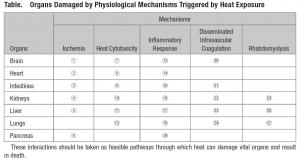
Deadly heat pathways
Brace yourself for coming heatwaves, there are at least 27 ways they can kill you
From University of Hawaiʻi at Mānoa Nov 9, 2017
A new systematic synthesis by researchers at the University of Hawai‘i at Mānoa shows that there are at least 27 different physiological pathways in which a heatwave can kill a human being, and everyone is at risk.
Around the world, numerous cases have revealed the considerable dangers of extreme heatwaves. More than 70,000 people perished to the extreme heat of the 2003 European heatwave, more than 10,000 people to the 2010 Russian heatwave, and more than 2,000 in the 2015 India heatwave. Altogether more than 800 cases of deadly heatwaves have been documented worldwide since 1980.
At times, the impacts of deadly heat are not measured in human lives, but in the numbers of people imprisoned indoors. In the last two years, millions of Americans have been told to stay indoors in cool places to avoid dangerous heat outdoors. Unfortunately, according to recent studies these deadly heatwaves are projected to worsen even with aggressive mitigation of greenhouse gases.
The significance of this deadly heat will depend on the sensitivity of the human body to heat, and a new synthesis paper in the American Heart Association journal Circulation: Cardiovascular Quality and Outcomes shows that we are more sensitive to heat than people may think.
“We know of many case examples when people have died as a result of heatwaves,” says Camilo Mora, associate professor of geography in the College of Social Sciences at UH Mānoa and lead author of the study. “However, why people died is a question whose answer is scattered.”
In this paper, the researchers carried out a systematic review of medical literature into the known ways in which heat kills people. They identified five physiological mechanisms with impacts on seven vital organs. Then, they carried out secondary searches using as keywords all possible combinations of mechanisms and vital organs to ensure a systematic search of the literature. Out of 35 possible interactions (i.e., five mechanisms times seven vital organs), the authors found medical evidence for 27 of such interactions (see Table). Basically, there are at least 27 ways in which things can go wrong during a heatwave.

Feasible pathways through which heat can damage vital organs and result in death.
Briefly, when the body is exposed to extreme heat, the hypothalamus generates a reaction in which it redirects blood flow to the skin, with the purpose of cooling down. This compensatory shunting of blood to the skin results in inadequate blood flow to other organs (a mechanism called Ischemia), where it creates anoxic conditions and damaging chemical compounds. In turn, if body temperature surpasses the optimal body temperature (because it is too hot), this will damage cells directly in a mechanism referred as heat cytotoxity. Both ischemia and heat cytotoxity are deadly conditions that can impact the functioning of the brain, heart, kidneys, liver, and perhaps more critically your guts.
While ischemia and heat cytotoxity can be lethal by themselves, the set of physiological responses to those two attacks pose an even greater risk of death. For instance, breaking of the intestine lining due to the chemical assault from ischemia and the thermal attack from heat cytotoxity, leads to the release of the gut content into the blood stream, which causes a third mechanism referred as “Systemic inflammatory response.” In this, the body triggers an inflammation that facilitates access of white blood cells to fight the infection. However, the same inflammation that allows for white blood cells can also facilitate further leakage of the guts and other organs whose membranes have been broken.
During all the internal mess created by ischemia, heat cytotoxity and the systemic inflammatory response, proteins that control blood clogging become overactive causing clots that can cut off blood supply to the brain, kidneys, liver and lungs; a mechanism called Disseminated Intravascular Coagulation. In turn, depletion of clotting proteins can lead to potentially fatal hemorrhaging even without injury. The final mechanism occurs when ischemia and heat cytotoxity, compounded by extraneous activity (e.g., going on a hike, exercising, working outdoors, farming, etc.), cause the breaking of skeletal muscle cells resulting in the leakage of myoglobin, which is toxic to the kidneys, liver and lungs.
“Dying during a heatwave is like a terror movie with 27 bad endings to choose from,” says Mora. “It is remarkable that humanity overall is taking such a complacency on the threats that ongoing climate change is posing.”
The paper further suggest that all heat damaging mechanisms can be triggered any time heat conditions are experienced, suggesting that anyone is at risk, with much greater risk for people with physical deficiencies or who cannot afford lifesaving tools, such as air conditioning.
In the paper, the authors comment that in the last decade, there has been a more than 2,300 percent increase in the loss of human life from heatwaves as a result of approximately less than 1°C warming. With 27 ways to die from extreme heat, the death toll that occurred with less than 1°C of warming emphasizes the heightened risk to human life even under the optimistic target of allowing the planet to warm up by another 1°C.
“Clearly, reducing the dangers of a warming world will require us to outperform even our most optimistic projections of climate change mitigation yet,” the authors conclude.
---30---
SA: Kidney failure, blood clots, cardiac arrest, inflammation of the pancreas, leaking intestines